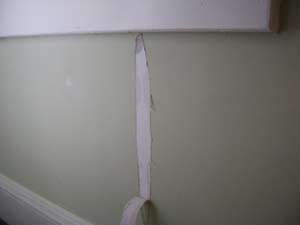For small holes as much as approximately ½” you can merely use spackling compound and a putty knife. Use steel snips to chop a piece of recent corner bead to suit the restore area (image 3). Apply a coat of joint compound to the nook, set the bead in place then apply one other layer of joint compound over it. Let dry utterly then add one other layer or two of compound depending on what is required (picture four). The important thing to patching torn drywall paper is to seal it first with an oil- or shellac-based sealer (KILZ Unique and BIN are two manufacturers).
When making use of the compound, hold the knife at a 70-diploma angle and swipe throughout the crack. If there are no electrical or plumbing traces present, use a drywall saw to punch a gap via the drywall along your line. Then there are two methods to fix nail pops: use a screwdriver or hammer to drive the nail again into the studs (picture 1), then bracket every nail head with carefully spaced drywall screws (picture 2); or, remove the nail and drive a screw as a substitute, together with a second screw nearby, to re-secure the drywall to the stud.
I patched two of the small ones myself however realized I neither had the instruments or skills to patch large holes in the toilet and laundry room. To fix a small hole, fill it with vinyl spackling compound , however first slightly dent the surface with a hammer to provide a void. Apply joint compound to each side of the nook, masking the bead patch to clean rough edges and canopy any seams, feathering the perimeters.
For deeper or bigger holes, drywall restore kits are bought that normally embody both simple metallic clips that assist a replacement piece or some kind of backerboard that inserts into the outlet and suspends itself in place when you cowl it with joint compound. I have seen regular Joe’s that do a fantastic job at repairing small drywall patches. Before applying the patch, you narrow the opening in the wall to an oblong form that matches the patch, utilizing a utility knife, saber noticed, or jab noticed.
Set the drywall patch in place and screw it into the furring strips, sinking the screws beneath the surface of the drywall. Apply two further coats, with a 10’ drywall knife, feathering the compound out evenly over the adjoining floor. You’ll not discover a more detailed drywall eBook out there. End all repairs with a closing gentle sanding to make sure a satin clean end and seamless mixing between the patch and the wall.
